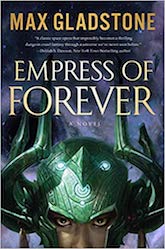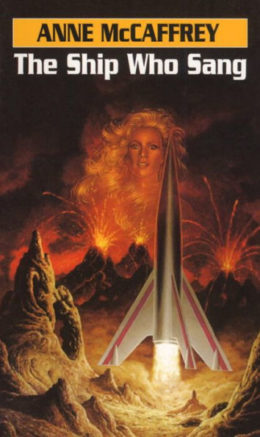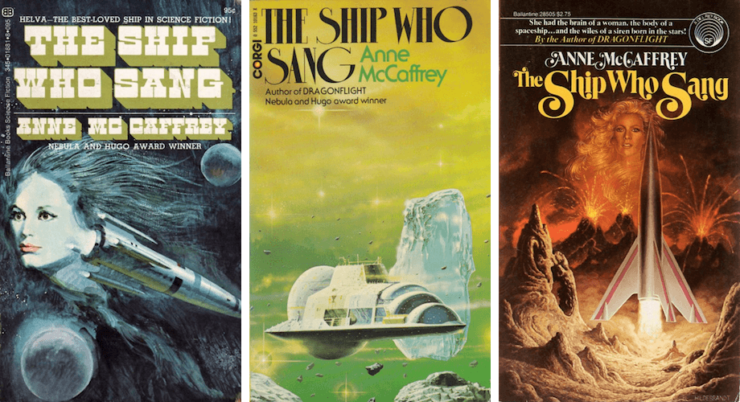In this bi-weekly series reviewing classic science fiction and fantasy books, Alan Brown looks at the front lines and frontiers of the field; books about soldiers and spacers, scientists and engineers, explorers and adventurers. Stories full of what Shakespeare used to refer to as “alarums and excursions”: battles, chases, clashes, and the stuff of excitement.
In the 1960s, a time when female voices were underrepresented in science fiction, Anne McCaffrey was an exception. McCaffrey’s most famous books were the Dragonriders of Pern series (currently the subject of a Tor.com reread led by the incomparable Mari Ness). But, while the subject of only six short tales, one of McCaffrey’s most memorable characters was Helva (also called XH-834), who became known throughout the galaxy (and science fiction fandom) as The Ship Who Sang.
In researching this article, I was surprised to find that the tales incorporated into McCaffrey’s The Ship Who Sang fit into a single, slim volume. While there were more books written with co-authors at a later date, McCaffrey wrote all of these initial tales alone, and while they are relatively few in number, they had a large impact. I encountered the first story in an anthology, early in my reading career, and others when they appeared in various magazines. The stories were memorable, and Helva was a sympathetic and compelling protagonist. I remembered them for years, long after I’d forgotten many of the other tales I read in that era. McCaffrey didn’t produce a large quantity of stories about Helva, but those she wrote were of the highest quality.
About the Author
Anne McCaffrey (1926-2011) was an American science fiction writer who spent her later years living in Ireland. Her career spanned more than four decades. As mentioned above, she is most widely known for her Dragonriders of Pern series, a science fiction epic that started with a single story in Analog magazine, something that surprises many fans, as the series has many of the trappings of fantasy fiction. The series eventually grew to encompass 21 novels, with later volumes co-authored with her son Todd.
She is also known for her Brain & Brawn Ship series, which followed the adventures of ships guided by the brains of humans who have such severe disabilities they cannot survive outside a life support cocoon within the vessel. These titular “Brains” are paired up with unmodified humans (the “Brawns”) who perform physical tasks that are required to achieve the ships’ missions.
Buy the Book


Empress of Forever
The Ship Who Sang, which was published in 1969, is more of a collection of stories integrated into a “fix-up” than a straightforward novel, with most of the chapters being reworked versions of tales first published in short story form, though the last chapter is original to the book. The short story “The Ship Who Sang” was one of the first stories McCaffrey ever wrote, and was published in The Magazine of Fantasy and Science Fiction in 1961. It was also selected by editor Judith Merril for one of her Year’s Best anthologies in 1962. The other stories that made up chapters in the novel first appeared in Analog, Galaxy, and If magazines. Under the sponsorship of Baen Books, the Brain & Brawn series eventually grew to include six additional novels, four written by co-authors working with McCaffrey, and two more written by the co-authors alone.
McCaffrey also wrote novels set in the Acorna, Crystal Singer, Ireta, Talents, Tower and Hive, and other universes, along with some solo novels and short story collections. She was the first woman to win a Hugo Award, and the first to win a Nebula Award (in 1968 and 1969, respectively). Because of the strength and popularity of her entire body of work, she was recognized as a Science Fiction and Fantasy Writers of America Grand Master, and inducted into the Science Fiction Hall of Fame.
Brains and Cyborgs
Disembodied brains have been a staple of science fiction since the early days of the genre. Often the subject of horror stories, they have menaced many a protagonist with their advanced mental powers. Becoming a cyborg, with one’s brain embedded in machinery, or with devices grafted onto a human body, was often presented as a fictional fate worse than death. Characters would implant mechanical devices in their bodies to give themselves additional abilities, often with malevolent intent. The evil biological/mechanical hybrid Borg of the Star Trek series are just one of the many incarnations of this trope.
In McCaffrey’s world, however, the melding of man and machine was seen in a much better light. Becoming a “shell person” or “encapsulated brain” is presented as a positive, humane opportunity for people with severe physical disabilities, allowing them to develop their exceptional talents and intelligence. At that time, when even the simplest of computers filled entire rooms, and even the most forward-thinking stories depicted characters using slide rules on the bridges of their spaceships, using a human brain for complex tasks seemed more likely than using some sort of mechanical intelligence. So McCaffrey postulated a universe where spaceships, and even cities, were managed by human brains linked directly to electrical and mechanical control systems, able to manage complex systems as instinctively as they might their own bodies. And she even anticipated the controversies inherent in the concept, projecting that there would be societies who opposed humans being used in this manner, and other groups who would work to protect their rights and prevent their enslavement.
(Incidentally, if you are interested in more information on theme of cyborgs, and a list of works that incorporate the theme, you might start with this Encyclopedia of Science Fiction article on cyborgs.)
The Ship Who Sang
The first chapter bears the title of the collection, “The Ship Who Sang.” It starts with Helva’s birth, and guides us through the early years of her life, as she is prepared for life as the guiding intelligence, or “Brain,” for a starship. Modern readers might be surprised by this somewhat leisurely approach to the narrative, as current styles call for dropping the reader into the midst of action, and for “showing” rather than “telling.” But it is the story that is most compelling, here, not the prose. From the start, Helva proves to be clever and intelligent. And she takes a particular interest in music, using her mechanical abilities to sing in ways that are beyond the abilities of a normal human. She is approached by a “Brawn,” a man trained as a partner for a brainship, and decides to invite more of his counterparts aboard so she can choose a partner carefully. And she is taken by one in particular, Jennan, with whom she falls in love. The feeling is mutual, and they form a deep attachment. But during one of their earliest missions, in an effort to save colonists from an overheating sun, Jennan sacrifices himself so that more colonists can be saved. Helva sings her loss. The story is compact, but deeply moving. Despite the oddities of her situation, we empathize with Helva as a human, and we grieve with her.
The second tale is called “The Ship Who Mourned,” and we find Helva still grieving the loss of Jennan. She is temporarily partnered with a medical officer named Theoda—not a Brawn, but a physiotherapist picked for a specific mission. They travel to a planet gripped by a plague that leaves victims paralyzed and uncommunicative. Theoda comes from a planet that faced a similar malady, and finds that the patients can be treated with physical therapies. (Anachronistically, and despite her professional credentials, her efforts are originally dismissed as “woman’s intuition.”) It turns out that Theoda lost her entire family on her home planet. Through working together on their mission and sharing their losses, Helva and Theoda find some comfort.
The third story, “The Ship Who Killed,” opens with Helva taking on another Brawn, this one a young woman named Kira. Their mission is to collect embryos from around the galaxy, three hundred thousand of them, and take them to a planet whose population had been sterilized by an ecological catastrophe. Kira is a personable companion and a “Dylanist,” someone who uses songs to promote social justice. (I have never been a Bob Dylan fan, and found the idea of him inspiring such a movement a bit preposterous.) It turns out that Kira has lost her mate, and before they could freeze any embryos, so she is grieving, just as Helva still feels the loss of Jennan. They are ordered to proceed to the planet Alioth, which turns out to be ruled by religious fanatics, and trouble ensues. They find themselves in the clutches of a death cult that worships an insane brainship. And Helva finds that she must use her musical abilities and what she has learned from Kira about the power of song to save them both, along with the people of the planet, from destruction.
The fourth tale is called “Dramatic Mission,” which I first thought would be about a mission with lots of dramatic events occurring. Instead, Helva is tasked with transporting a drama company to an alien planet, where they will put on plays in return for the aliens giving technological secrets to the humans. She is currently partnerless, as her three-year “stork run” with Kira has ended. The drama company is full of conflict, with a leader who is a drug addict close to death, and a female lead picked more for political than professional reasons. When the company, who are preparing Romeo and Juliet, find that Helva knows Shakespeare, she is drawn into playing a role. And at their destination, they find that the aliens can download personalities into alien bodies, and Helva finds herself for the first time in a physical body outside her shell. That process turns out to be very dangerous for humans, and they soon find themselves ensnared in a web of betrayal and hatred that pushes Helva to her limits.
The penultimate chapter is “The Ship Who Dissembled.” Helva is partnered with the infuriating Teron, who has proved to be a terrible Brawn. And to make matters worse, she had picked Teron over the objections of her officious boss, Niall Parollan, and doesn’t want to admit that he was right. Brainships have been disappearing, and at one of their stops, Teron allows some officials aboard over Helva’s objections; these officials then kidnap them, although Helva has left an open channel with Parollan that might offer a chance for rescue. Helva finds herself stripped from her ship and left in a state of sensory deprivation. She is with the Brains of other captured ships, and some of them have succumbed to insanity under the stress. With no resources other than her wit and her ability to synthesize sound, Helva must find a way to foil her captors and save the day.
Buy the Book


The Ship Who Sang
The final story, written specifically for this volume, is “The Partnered Ship.” Helva has earned enough credits to pay off her debts and become an independent entity. But Parollan and other officials bring her an offer. If she agrees to extend her contract, she will be fitted with a new, extremely fast star drive, the fruit of the trade with the Shakespeare-loving aliens. Parollan, however, is acting strangely during these negotiations… It turns out that he has long had a crush on Helva. Despite the fact that they bicker constantly, she is flattered by his ardor, and feels he brings out the best in her. So, finally putting behind her loss of Jennan, Helva takes on a more permanent partner, and looks forward to an exciting new life on the far frontiers of space.
As a young reader, I was mostly drawn by the adventure aspects of these stories. But as an older reader, I was struck by the depth of the emotions they portrayed. They are deeply moving meditations on love, loss, perseverance and rebirth. While McCaffrey is a competent writer of action stories, in these tales she wears her emotions on her sleeve in a way that her contemporaries generally did not, and the stories are stronger as a result.
Final Thoughts
The Ship Who Sang represents a small portion of Anne McCaffrey’s body of work, but because of the strength of those stories, the book is often mentioned as some of the best of her fiction. There are some aspects of the stories that feel a bit dated, but they remain as powerful today as when they were first written.
And now it’s your turn to comment: What are your thoughts on The Ship Who Sang? How do you feel it ranks among the author’s other works? And are there any other tales of cyborgs that you found as memorable as Helva’s adventures?
Alan Brown has been a science fiction fan for over five decades, especially fiction that deals with science, military matters, exploration and adventure.










